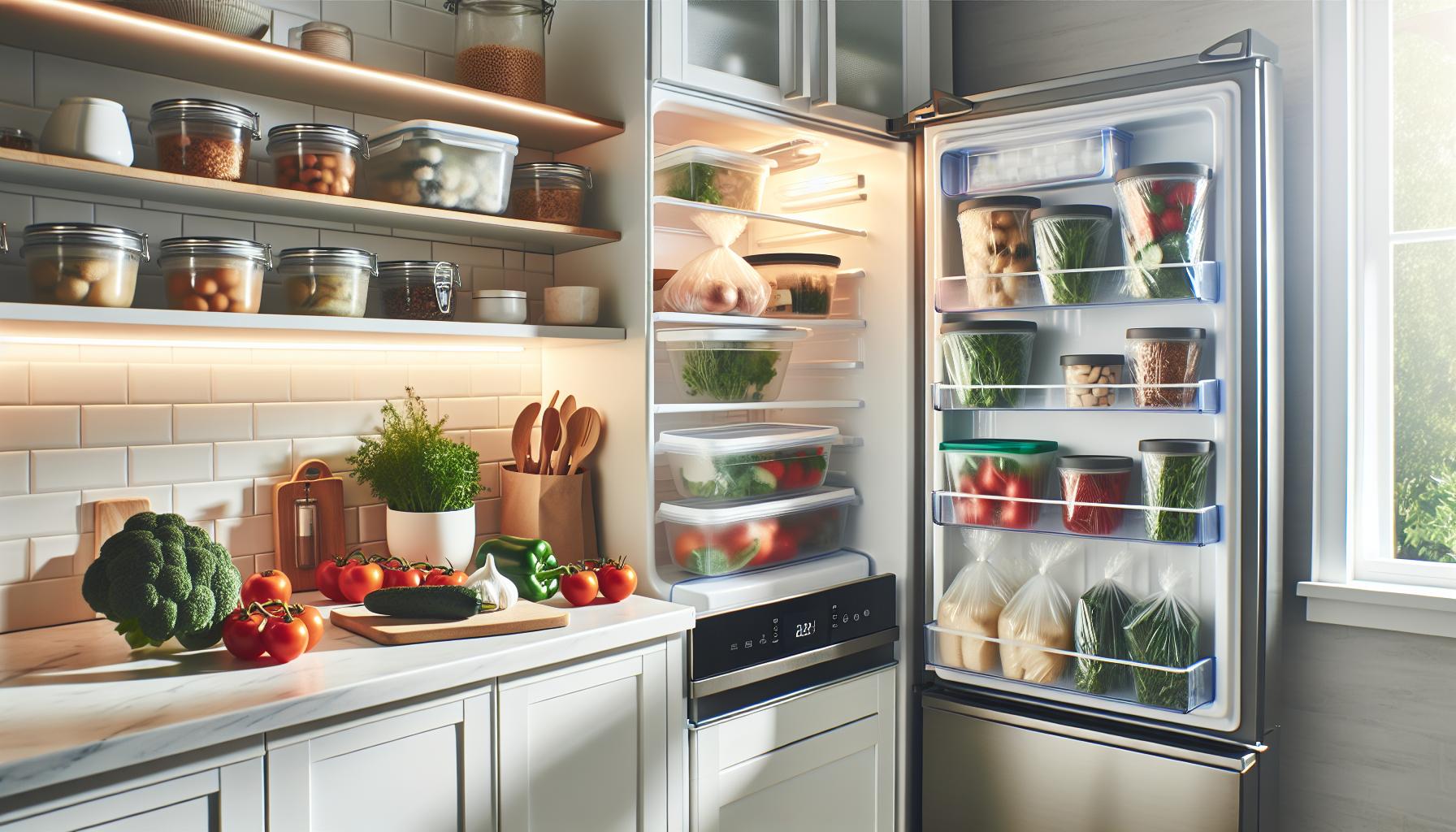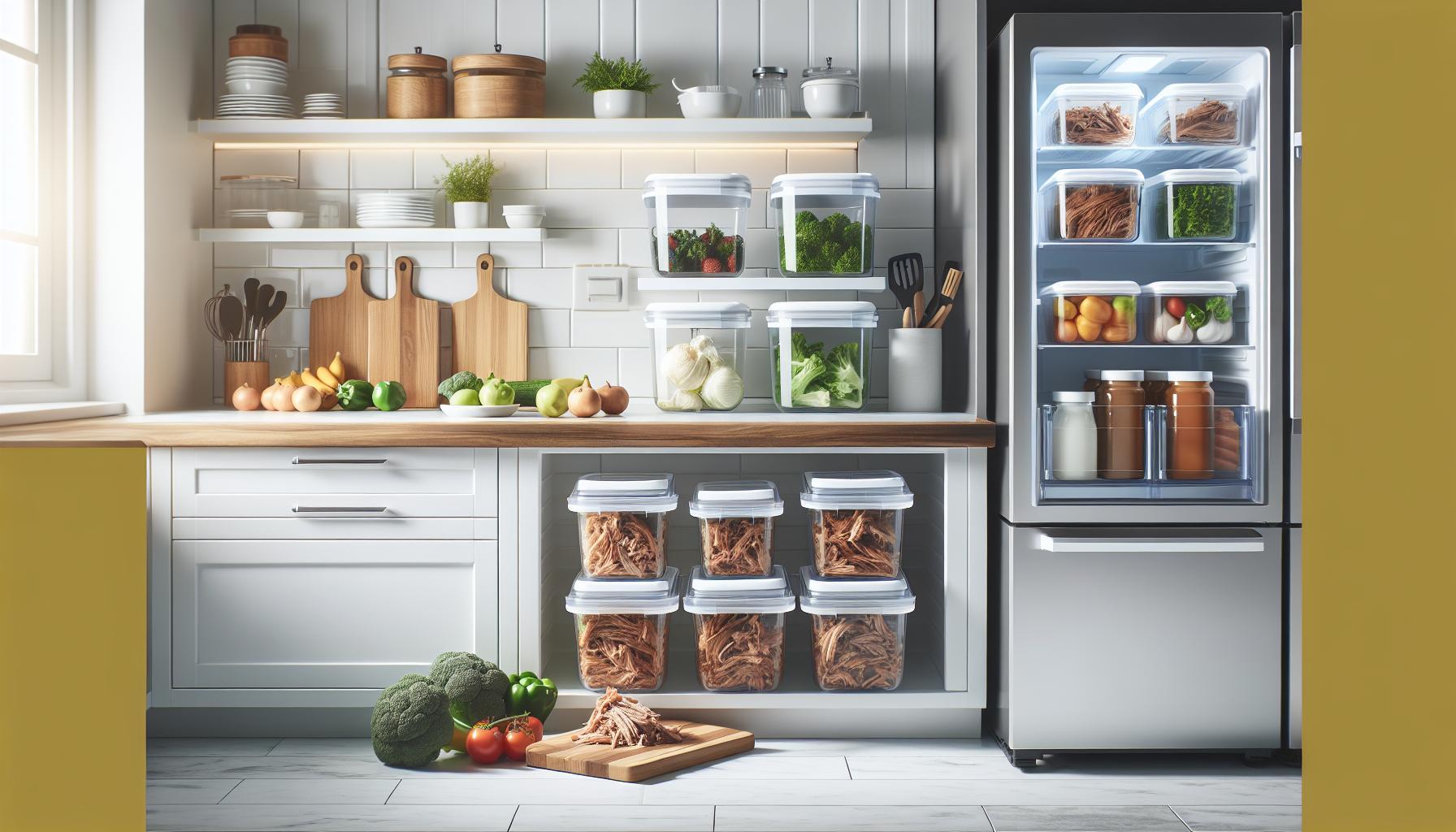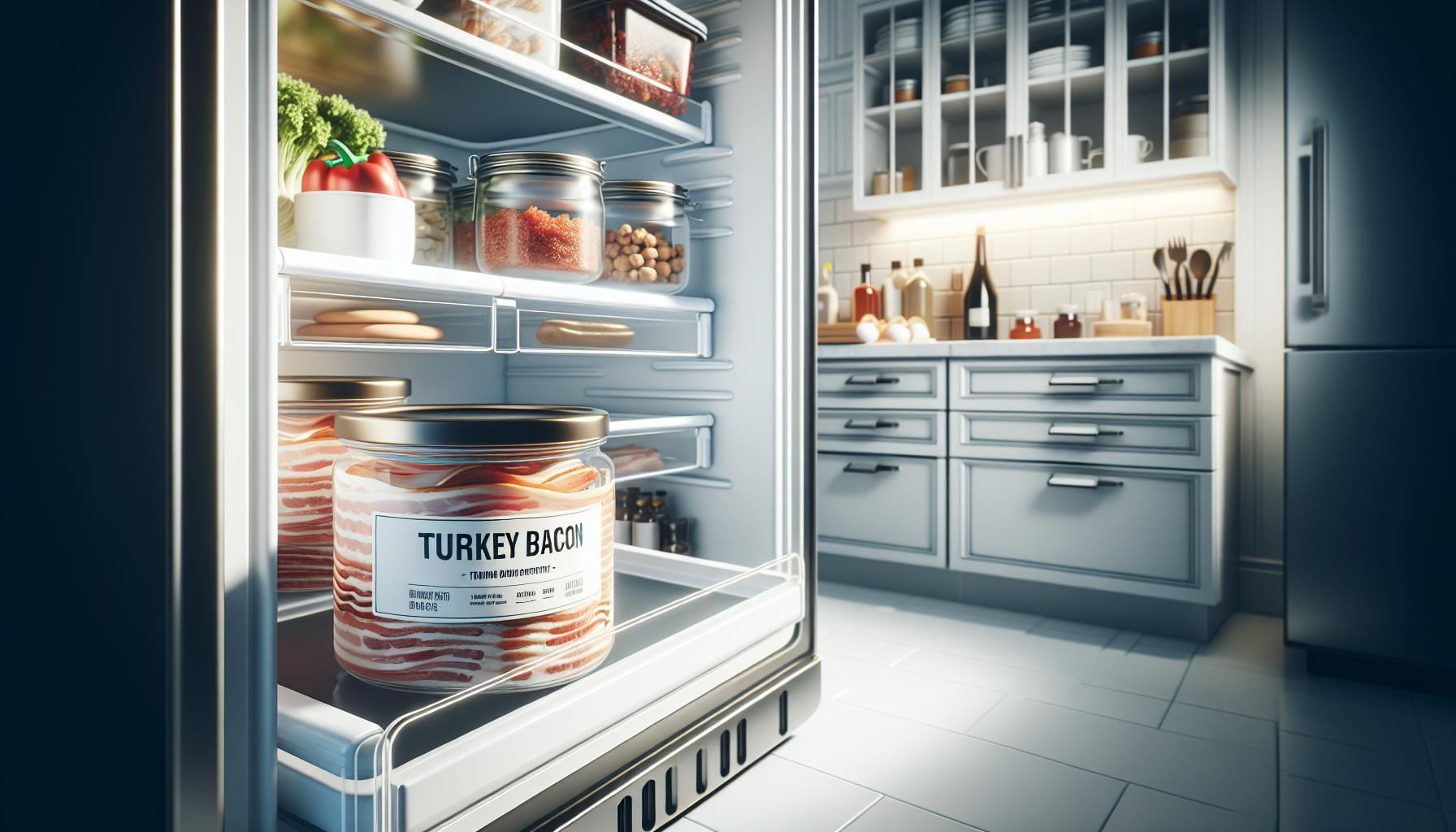Cooked gammon can be a delicious centerpiece for any meal, but knowing how long it lasts in the fridge is essential for food safety and maximizing your leftovers. Leftover gammon not only saves you time but also offers versatility in your meals-think sandwiches, salads, or stir-fries.
Understanding proper storage times ensures you enjoy your gammon without the worry of spoilage. After all, no one wants to toss out perfectly good food! In this article, we’ll provide you with practical guidelines for storing cooked gammon, helping you make informed decisions to keep your leftovers safe and tasty for longer. Let’s dive into the details and ensure your meals remain delightful and worry-free!
How Long Can Cooked Gammon Stay Fresh in the Fridge?
Cooked gammon, known for its rich flavor and versatility, can be a delightful addition to your meals. However, to ensure it remains safe to eat, you should be aware of how long it can stay fresh in the fridge. Generally, cooked gammon can be safely stored in the refrigerator for about 3 to 5 days. This timeframe allows you to enjoy leftovers without compromising on safety or flavor.
To maximize the freshness of your cooked gammon, it’s vital to store it correctly. Ensure it is tightly wrapped in plastic wrap or aluminum foil, or place it in an airtight container. This protection minimizes exposure to air, which can cause it to dry out and affect its taste. It also helps to prevent cross-contamination from other food items in your fridge.
Always be vigilant about food safety. If you’re unsure about the freshness of your cooked gammon, check for signs of spoilage, such as an off smell or a change in color or texture. When in doubt, it’s best to err on the side of caution and discard any questionable food items. By following these guidelines, you can confidently enjoy your cooked gammon and make the most of your leftovers.
Signs That Cooked Gammon Has Gone Bad
To ensure your culinary creations, especially cooked gammon, remain safe and delicious, it’s crucial to recognize the signs that tell you when it has gone bad. Spoiled meat can pose serious health risks, so understanding these indicators is essential for food safety and enjoyment.
The first and most noticeable sign of spoilage is the odor. Fresh cooked gammon has a distinct, savory smell, but if it starts to emit a sour or rancid odor, this is a clear indication that it has spoiled and should not be consumed. Discoloration can also signal issues; if the meat has developed a gray, green, or dull hue, it’s wise to err on the side of caution and discard it. Similarly, examining the texture can provide clues. Fresh gammon should be moist but firm; if it feels excessively slimy or sticky, it has likely become a breeding ground for bacteria.
Another important factor to consider is the duration of storage. Although cooked gammon can generally last in the refrigerator for 3 to 5 days, if you’re nearing the end of that timeframe and notice any of the aforementioned signs, it’s safest to throw it away rather than risk foodborne illness. Always follow the mantra: “When in doubt, throw it out.” Regular checks of your refrigerated items will help you stay ahead of spoilage and keep your meals safe.
Best Practices for Storing Cooked Gammon
Storing cooked gammon properly is essential for both flavor preservation and food safety. One fundamental rule is to allow any leftover gammon to cool to room temperature before refrigeration; this helps to prevent condensation, which can promote bacterial growth. Once cooled, wrap the gammon tightly in foil or plastic wrap to minimize exposure to air and moisture, which can lead to spoilage. Alternatively, you can place the gammon in an airtight container.
Ensure your refrigerator is set to a temperature of 40°F (4°C) or lower to keep the gammon fresh for its maximum shelf life of 3 to 5 days. It’s wise to label your storage containers with the date of cooking to stay organized and aware of freshness. If you’re aiming to keep it longer, consider slicing the gammon into smaller portions, which can not only aid in quicker cooling but also make it easier to thaw and reheat for future meals.
For those planning to store cooked gammon beyond a week, freezing is an excellent option. When freezing, use freezer-safe bags or containers, ensuring as much air as possible is removed before sealing. Cooked gammon can last in the freezer for up to three months without significant loss of quality. Just remember to label them with the date to track storage time efficiently. When properly stored, your delicious gammon can remain a convenient meal option, ready to be enjoyed at any moment.
How to Reheat Cooked Gammon Safely
When it comes to enjoying the delicious flavors of cooked gammon, reheating it correctly is essential not only for taste but also for food safety. Improper reheating can lead to foodborne illnesses, so following specific guidelines can help retain its moisture and flavor while ensuring it’s safe to eat.
To start, always aim to reheat your cooked gammon to an internal temperature of 165°F (74°C). This temperature is crucial to effectively kill any potential bacteria that may have developed during storage. Using a food thermometer is the best way to ensure it has reached this safe temperature.
For reheating, several methods can be used depending on your preference and available equipment:
Oven Method
Reheating in the oven is a great way to maintain moisture and achieve an evenly warmed dish. Preheat your oven to 325°F (163°C). Wrap the gammon loosely in aluminum foil to prevent it from drying out and place it in the oven. Reheat for about 15-20 minutes per pound, checking the temperature with a thermometer to ensure it has reached 165°F.
Microwave Method
The microwave is the fastest option, but it can sometimes lead to uneven heating. Cut the gammon into smaller pieces and place it on a microwave-safe plate. Cover it with a damp paper towel to help retain moisture. Heat on medium power in 30-second intervals, checking its temperature until it reaches 165°F.
Stovetop Method
If you prefer a pan, reheating on the stovetop is also effective. Place a skillet over medium heat and add a small amount of water or broth. Add the gammon, cover the skillet to create steam, and heat for about 10 minutes until warmed through, checking the internal temperature as you go.
Regardless of the method chosen, never leave cooked gammon at room temperature for more than two hours prior to reheating, as this can increase the risk of bacterial growth. Following these guidelines will ensure that your leftovers remain safe, tender, and tasty, ready to be enjoyed without worry.
Creative Ways to Use Leftover Cooked Gammon
Leftover cooked gammon is a versatile ingredient that can elevate various dishes, ensuring nothing goes to waste in the kitchen. After enjoying it sliced cold or as part of a classic sandwich, consider these creative approaches to repurpose your leftovers while maximizing flavor and satisfaction.
One delightful way to use leftover gammon is to incorporate it into hearty soups and stews. The savory flavor of gammon adds depth to lentil soup or split pea soup, enriching the broth and providing a protein boost. Simply dice the gammon and add it during cooking to allow the flavors to meld harmoniously.
Another excellent option is to transform leftover gammon into a filling for savory pastries or pies. Utilize pre-made puff pastry or shortcrust pastry to create delicious hand pies filled with chopped gammon, sautéed onions, cheese, and some fresh herbs. These can be baked for a flaky, satisfying snack or meal that showcases the gammon’s flavor.
Gammon also shines in breakfast dishes. Diced gammon makes an excellent addition to scrambled eggs or omelets, creating a protein-rich start to the day. Consider whipping up a gammon and cheese frittata or mixing it with hash browns for a delightful brunch option that brings family and friends together.
For those looking to enjoy gammon in a more adventurous format, try incorporating it into a stir-fry. Slice the gammon into thin strips and sauté it with seasonal vegetables and your choice of sauce for a quick and flavorful dinner. This method adds a smoky hint to your meal, demonstrating the gammon’s flexibility and ability to pair well with various flavors and cuisines.
By creatively using your leftover cooked gammon, not only do you minimize waste, but you also enrich your meals with its delicious taste and texture. Whether in soups, pastries, breakfasts, or stir-fries, gammon can easily adapt to fit various culinary styles while keeping your dining experience delightful.
Understanding the Shelf Life of Different Gammon Types
Understanding the variety of gammon types and their respective shelf lives can greatly enhance your food storage practices and reduce waste. Generally, cooked gammon can be enjoyed for 3 to 5 days when stored properly in the refrigerator. However, the exact timeframe can vary based on the specific type of gammon and how it’s prepared.
For instance, cold-cooked gammon, which has been sliced and is often used in sandwiches or salads, typically remains fresh for about 3 to 4 days. On the other hand, a large piece of whole cooked gammon, if kept intact and wrapped correctly, might last a bit longer-up to 5 days-due to less exposure to air and contaminants. It’s crucial to store gammon in an airtight container or tightly wrapped in plastic wrap or aluminum foil to maintain its freshness and prevent it from absorbing strong odors from the fridge.
Different curing processes also influence shelf life. Smoked gammon, with its higher salt content, can sometimes last a little longer, while green gammon (not fully cured) should be consumed more quickly, ideally within 2 to 3 days after cooking. Always inspect your gammon for any off smells or discoloration before consuming, and adhere to the basic food safety guideline: when in doubt, throw it out.
The best way to ensure that your cooked gammon stays safe and delicious is to store it as soon as it cools down, ideally within two hours of cooking. If you know you won’t consume the entire batch within this time frame, consider freezing any leftovers for longer storage. When frozen, cooked gammon can retain its quality for up to 3 months. Just ensure it is well-wrapped to prevent freezer burn. When you’re ready to enjoy it again, simply thaw it in the fridge before reheating.
In summary, understanding the variations in shelf life among different gammon types empowers you to enjoy this versatile meat safely and deliciously. By following these storage practices, you can ensure your cooked gammon remains fresh and flavorful for all your culinary adventures.
When to Freeze Cooked Gammon for Longer Storage
Freezing cooked gammon is an excellent way to extend its shelf life, ensuring you can enjoy this savory meat at a later date without the risk of spoilage. Generally, you should consider freezing your cooked gammon if you do not foresee finishing it within the 3 to 5 days recommended refrigeration window. Freezing not only retains flavor and moisture but also preserves nutritional value, making it a smart solution for leftovers.
To effectively freeze cooked gammon, it’s crucial to wrap it properly to prevent freezer burn and maintain quality. Ideally, allow the gammon to cool completely before wrapping. Once cooled, you can use freezer-safe plastic wrap or aluminum foil for initial wrapping. Placing the wrapped gammon in an airtight container or a sealable freezer bag will provide an additional layer of protection against freezer damage. Note that properly stored, cooked gammon can last up to 3 months in the freezer without significant loss in quality.
When it’s time to enjoy your frozen gammon, plan ahead for optimal results. To thaw, transfer the gammon to the refrigerator and let it defrost gradually for several hours or overnight. This method keeps the meat safe and helps retain moisture. Avoid thawing at room temperature, as this can promote bacterial growth. Once thawed, you can safely reheat the gammon and incorporate it into your meals, ensuring it’s heated to an internal temperature of 165°F (74°C) before consumption for safety.
In summary, freezing cooked gammon is a practical and effective method to enjoy your leftovers longer. By adhering to proper storage techniques, you can savor the delicious flavors of gammon even weeks after cooking, minimizing waste and enhancing your meal options.
Tips for Safe Food Storage to Avoid Waste
To optimize the freshness of your cooked gammon and minimize waste, implementing effective food storage practices is essential. Proper storage not only preserves the quality of your meat but also ensures safety, reducing the risk of foodborne illnesses. A crucial guideline to remember is that cooked gammon can be safely stored in the refrigerator for about 3 to 5 days. To maximize its shelf life, it’s imperative to cool the gammon promptly after cooking and store it in an airtight container. This prevents exposure to air, which can lead to spoilage and contamination.
- Use Airtight Containers: Choose containers that seal tightly to limit air exposure. Consider using vacuum-sealed bags for the best results. By keeping air out, you not only preserve moisture and flavor but also significantly delay bacterial growth.
- Labeling: Make it a habit to label containers with the date you stored the gammon. This simple step helps you keep track of timing and promotes food safety by ensuring that older leftovers are consumed first.
- Temperature Awareness: Always refrigerate cooked gammon promptly, ideally within two hours of cooking. Temperatures above 40°F (4°C) can induce bacterial growth, making timely refrigeration crucial for maintaining safety.
- Freezing Tips: If you anticipate that the gammon won’t be consumed within the refrigeration window, freeze it instead. Wrap it tightly in freezer-safe materials and label it with the date prior to freezing. When done correctly, frozen cooked gammon can last up to 3 months without significant quality loss.
By following these comprehensive storage practices, you can enjoy your cooked gammon longer while ensuring that it remains safe and delicious to eat. Proper planning and attentive care can help reduce waste and make the most of your culinary creations.
Myths About Meat Storage: Debunked
The world of meat storage is rife with misconceptions that can lead to unnecessary waste or, worse, food safety issues. One major myth is that all leftover meats remain safe indefinitely when stored in the fridge. In reality, while cooked gammon can be refrigerated, it should ideally be consumed within 3 to 5 days to ensure freshness and minimize the risk of foodborne illnesses. Beyond this time frame, harmful bacteria can multiply rapidly, even in a cold environment, making it crucial to adhere to recommended storage times.
Another common misunderstanding is that reheating meat to a high temperature will eliminate all potential hazards. While it’s true that heating food can kill bacteria, if the meat was stored improperly or kept too long, toxins produced by bacteria may not be destroyed by heat. To ensure safety, always refrigerate cooked gammon promptly, within two hours, and store it in airtight containers to prevent contamination from other foods.
Many people also believe that placing meat in the fridge as soon as it’s cooked is enough for its preservation. However, cooling cooked gammon quickly to room temperature before refrigeration is important, as lingering at warmer temperatures allows bacteria to flourish. The aim should be to get the meat into the fridge within two hours post-cooking for optimal safety.
Finally, a significant misconception surrounds the use of the freezer. Some think that freezing cooked meats indefinitely keeps them safe. While freezing can extend the shelf life of cooked gammon for up to three months, it’s important to wrap it properly using freezer-safe materials. Even in the freezer, the quality can deteriorate over time, affecting taste and texture. Using these best practices can help you maximize the safety and enjoyment of your leftover cooked gammon, ensuring fewer worries and more delicious meals.
Quick Guide: Cooking and Storing Gammon Safely
Cooking and storing gammon properly is essential not just for maximizing flavor but also for ensuring food safety. Many home cooks love the versatility of gammon, whether it’s the star of a holiday feast or a simple weeknight dinner. However, understanding the right practices for storing cooked gammon can help you avoid any potential waste or health risks.
To keep cooked gammon fresh, store it in an airtight container or wrap it tightly in aluminum foil or plastic wrap, ensuring that no air can reach the meat. This method helps prevent the growth of bacteria and keeps the gammon from absorbing other odors from the fridge. Ideally, cooked gammon should be consumed within 3 to 5 days when stored in the refrigerator. If you plan to keep it longer, consider freezing it, where it can last for up to three months without losing significant quality. Just be sure to use freezer-safe packaging to protect it against freezer burn.
When it comes to reheating your cooked gammon, ensure that it reaches an internal temperature of 165°F (74°C) to effectively kill any lurking bacteria. Never leave cooked gammon sitting at room temperature for more than two hours, as this can lead to rapid bacterial growth.
Lastly, as misconceptions about meat storage abound, remember that storing cooked and raw meats separately is critical. The last thing you want is cross-contamination that could jeopardize food safety. By adhering to these straightforward guidelines, you can enjoy your gammon in its best form while keeping food safety front of mind.
FAQ
Q: How can I tell if cooked gammon is still safe to eat?
A: To determine if cooked gammon is safe to eat, check for signs such as a sour smell, discoloration, or a slimy texture. If any of these signs are present, it’s best to discard the gammon to avoid foodborne illness. Refer to the “Signs That Cooked Gammon Has Gone Bad” section for more details.
Q: Can I eat gammon that’s been in the fridge for over a week?
A: Generally, cooked gammon should be consumed within 3 to 5 days when stored properly in the fridge. If it has been over a week, it’s safer to discard it. Always prioritize safety to prevent foodborne illnesses.
Q: What is the best way to store leftover cooked gammon?
A: The best way to store leftover cooked gammon is to wrap it tightly in plastic wrap or aluminum foil and place it in an airtight container before refrigerating. This helps maintain freshness and prevents contamination. Check out the “Best Practices for Storing Cooked Gammon” section for detailed tips.
Q: How long can cooked gammon be frozen for?
A: Cooked gammon can be frozen for up to 3 months. For optimal flavor and texture, ensure it’s well-wrapped in freezer-safe plastic or aluminum foil. Refer to the “When to Freeze Cooked Gammon for Longer Storage” section for more guidance.
Q: Is it safe to reheat cooked gammon more than once?
A: It is generally safe to reheat cooked gammon multiple times, but it’s important to ensure it reaches an internal temperature of 165°F (74°C) each time. Consistent reheating can affect quality; visit the “How to Reheat Cooked Gammon Safely” section for more tips.
Q: What’s the best way to use leftover cooked gammon?
A: Leftover cooked gammon can be creatively used in soups, salads, or sandwiches. It’s also delicious in pasta dishes or as a pizza topping. Check the “Creative Ways to Use Leftover Cooked Gammon” section for even more ideas.
Q: Can I store cooked gammon in a fridge door?
A: It’s not recommended to store cooked gammon in the fridge door due to temperature fluctuations. Instead, place it in the main body of the fridge where the temperature is more stable. Refer to the “Tips for Safe Food Storage to Avoid Waste” section for best practices.
Q: How should I thaw frozen cooked gammon?
A: The safest way to thaw frozen cooked gammon is to place it in the fridge overnight. Alternatively, you can use the microwave for quicker thawing, but it should be cooked immediately after. For more information, see the “When to Freeze Cooked Gammon for Longer Storage” section.
Closing Remarks
To enjoy your cooked gammon leftovers safely, remember they last up to 3-4 days in the fridge when stored properly. Don’t hesitate to dive into delicious recipes to repurpose your gammon, or check out our tips on how to freeze it for longer storage! For more insights on maximizing your leftover meals, explore our articles on food safety practices and meal planning strategies that can keep your kitchen experience thriving.
Feeling uncertain about food storage? Sign up for our newsletter for expert tips and the latest recipes delivered straight to your inbox! Share your favorite gammon dishes or storage hacks in the comments below-we’d love to hear from you. Remember, safe food practices not only preserve flavors but also ensure your meals remain delightful. Happy cooking!





